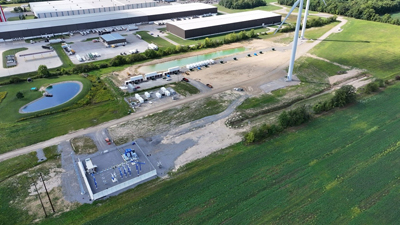The site power system can accommodate up to 30 MW of charging in its current configuration.
One Energy Enterprises Inc. unveiled the initial configuration and energization of its 30 megawatt (MW) electric semi-truck fleet charging site, located at its first Megawatt Hub in Findlay, OH, it announced in a news release.
The company’s plans to use its Power Island™ concept to configure electric semi-truck charging infrastructure to support multiple corporate trucking fleet operators at the same time.
The Findlay Megawatt Hub is the largest constructed or publicly announced truck charging site in the U.S. in terms of available charging capacity. The site power system can accommodate up to 30 MW of charging in its current configuration.
One Energy plans to use a radial charging configuration to optimize overall site efficiency, allowing multiple corporate customers to customize charging operations and equipment to their specific fleet’s needs. The site currently has fully functional capacity at medium and low voltages.
“From its inception, the electric semi-industry had an obvious chicken and egg problem,” said Jereme Kent, CEO of One Energy. “Truck manufacturers and fleet operators need to be able to charge at scale before they can move forward with deploying electric trucks at scale. This Megawatt Hub configuration solves that problem. The power is already on-site, at the right voltage, and we can outfit and energize custom Power Island configurations with the necessary charging equipment in weeks or months, not years.”
The electric semi-truck manufacturing industry has said a serious impediment to customer adoption of electric fleets has been getting enough power at the correct voltage from the grid to allow customers to connect their chargers. One Energy designed this site to solve that problem by delivering charger-ready power at scale. A 138,000-volt transmission line serves the Findlay Megawatt Hub. One Energy’s facility has the capacity to charge 90 trucks concurrently (based on a typical 300-kW charge rate). The company expects to obtain direct access to transmission service pricing to provide some of the lowest-cost energy available in the U.S. In addition, the site design allows it to host behind-the-meter renewable energy generation from wind and solar as demand at the site matures.
The Findlay Megawatt Hub was built by One Energy with its own capital and without government subsidies or grants. One Energy received no utility incentives for the site.
“Capital markets are good at building the second and third projects after the pilot has proven successful, but they have always struggled with underwriting the first one,” said Thomas Lause, CFO of One Energy. “Because we are confident in the solution and the technology, we decided not to wait. We just built it. Now we have a functioning site to show capital markets.”
Kent concluded, “We are throwing down a gauntlet to jumpstart the electric semi-industry. We have already built full-scale, cost-effective charging that can serve multiple end-users. We have done it in the manufacturing center of the United States, where there are numerous local and regional truck routes. Now we are excited to see the electric semi manufacturers deliver.”










Abby Andrews